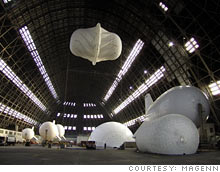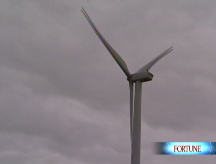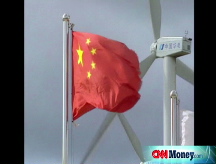Wind energy startups chase mile-high power
Magenn Power is betting big on high-soaring blimps.
 |
| The U.S. Department of Energy says wind could provide 20% of the nation's energy by 2030 - up from just 1% today. |
(Fortune Small Business) -- If you want to see the future of wind energy, look up.
The higher you go, the stronger and steadier the wind becomes - and the more power you can reap from it.
That's why Ottawa-based Magenn Power is building an airship to generate energy from high-altitude wind. CEO Pierre Rivard's helium-filled rotating blimps will hover at up to 1,000 feet - conventional turbines remain suspended at 300 feet - and use fabric sails that transmit energy to the ground via high-voltage cable tethers. The result: A single blimp can power up to five homes.
Because the wind stays constant at those heights, Magenn can provide power to locations where air currents may not be forceful or consistent enough for turbines to be economically viable. "We can tap into wind power virtually anywhere," Rivard says.
Rivard, 52, is a pilot, an aerospace engineer and a true believer in blimps. In 2007 he quit his job as CEO of the publicly traded Hydrogenics Corp. (HYGS), which specializes in clean energy and hydrogen power, and invested $1.9 million of his own money in Magenn. The company was founded in 2004 by Fred Ferguson, 59. In the 1980s, Ferguson designed electric-powered blimps for an aerial freight-delivery business that never took off. Twenty years later, he realized his designs were more suited to creating energy than using it.
Magenn's six engineers struggled to turn that vision into reality. They dealt with airships that wouldn't stay pointed in the right direction and fabric that tore in high winds. At one point, Ferguson considered closing the operation because he couldn't get funding, but ultimately decided to press on. "You have to bump your head against the wall until you find a solution," Rivard explains.
Magenn finally developed a working prototype. Today the company boasts that it has secured $5 million from investors and a $1 million renewable energy grant from the Canadian government, plus its first customer, the Sandbanks Provincial Park on the shores of Lake Ontario. The company's 10- to 25-kilowatt airship debuts there in 2009, and a more powerful 100-kilowatt system should take flight in 2010.
"Our technology will be a game changer in wind energy," Rivard says.
Magenn still hasn't put a price tag on its airships, but Rivard expects them to eventually cost about $2,400 per kilowatt generated, on par with conventional wind turbines. Initially, Rivard is focusing on providing power to off-grid operations that rely on pricey diesel-fueled generators, such as mining sites, oil wells and large campgrounds. Provincial officials in Ontario, which has pledged to rid itself of coal-fired plants by 2014, are providing public land to test and fly the blimps. Eventually those officials would like to see Magenn power 4,900 far-flung homes and businesses in northern Ontario that are difficult to reach in winter.
"We're really encouraged," says Kevin Wilson, an assistant deputy minister in the Ontario Ministry of Natural Resources. "It's at least a partial solution to these energy needs."
Magenn won't have the whole sky to itself next year: High-altitude wind-energy startups are taking off everywhere. In Research Triangle Park, N.C., WindLift Kite Engine Co. will unveil a smaller kite system to help off-grid communities in India power water pumps. At $2,000, the contraption will cost a fraction of the $40,000 needed to buy a 10-kilowatt wind turbine, according to Robert Creighton, WindLift's founder.
Similarly, Italian company Kite Gen Research aims to build 100-megawatt electric plants that use software and onboard avionic sensors to automatically pilot multiple generator kites in half-mile-diameter paths. And Google (GOOG, Fortune 500) invested $15 million in Makani Power, a secretive wind-energy company in Alameda, Calif.
Then there's Sky WindPower in Murrieta, Calif., which wants to use a tethered 100-kilowatt rotorcraft to draw wind power at an altitude of up to 30,000 feet. Think of a helicopter with no pilot cabin, four rotors and an electric cable tether. The wind turns the rotors and the resulting power travels down the tether to the ground. The only disadvantage, from an environmental perspective, is that you need a generator to lift the device into the air in the first place.
All these startups hope to grab a tiny piece of the $37 billion global market for wind energy. The U.S. accounts for $10 billion of that sum, and the market is expected to grow by as much as 30% in 2009. The U.S. Department of Energy says wind could provide 20% of the nation's energy by 2030 - up from just 1% today.
"If you can crack this thing, you have the potential to tap an immense amount of power," says David Lang, a former NASA aerospace engineer and board member for the Drachen Foundation, a nonprofit Seattle kite-power education group. "Once you build the plant, the wind is free."
Still, these technologies come with some confounding challenges. Entrepreneurs must ensure that heavy electric cable lines don't get tangled, and they must develop a plan for extreme weather. In the U.S., any flying generator needs a permit from the Federal Aviation Administration to ensure that it doesn't obstruct air traffic.
"The real challenge is to do this and be competitive with existing wind technology," says Bob Thresher, a research fellow at the National Renewable Energy Lab in Golden, Colo. "But it is technically feasible, and it will work." ![]()
Full package: Next Little Thing 2009
Where are they now? See how out past Next Little Things have done.
Cheap power for tomorrow: 5 projects
Riding the wind: A seasoned kiteboard entrepreneur teaches newbies to surf flat water.
-
The Cheesecake Factory created smaller portions to survive the downturn. Play
-
A breeder of award-winning marijuana seeds is following the money and heading to the U.S. More
-
Most small businesses die within five years, but Amish businesses have a survival rate north of 90%. More
-
The 10 most popular franchise brands over the past decade -- and their failure rates. More
-
These firms are the last left in America making iconic products now in their twilight. More













